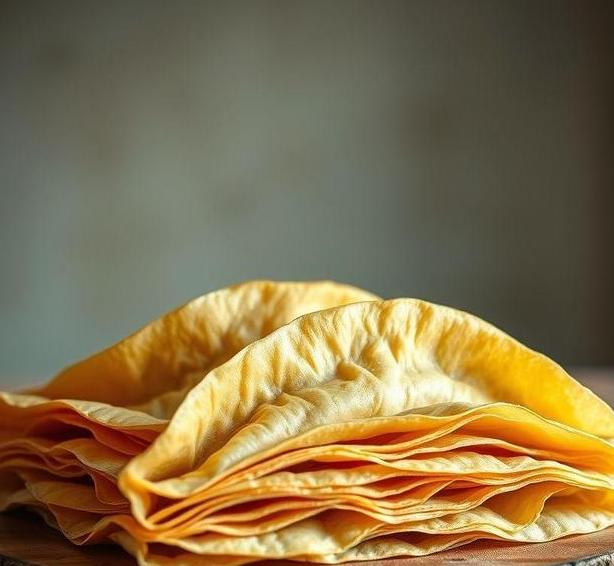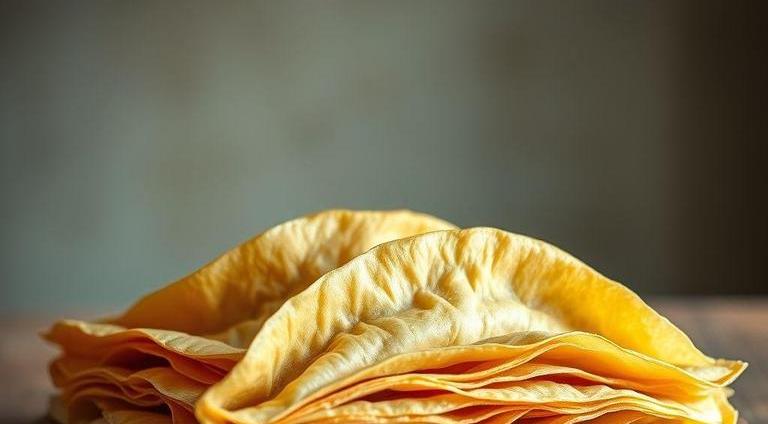Phyllo dough, also known as filo or fillo dough, is a delicate, paper-thin pastry often used in Mediterranean and Middle Eastern cuisines. Its versatility makes it a favorite for sweet and savory dishes like baklava, spanakopita, and samosas. But like most perishable ingredients, phyllo dough doesn’t last forever. If you’ve ever found an old package tucked away in your pantry, you might wonder: Can phyllo dough go bad?
In this guide, we’ll explore the shelf life of phyllo dough, how to store it properly to prolong its freshness, and how to recognize when it has spoiled. By the end, you’ll know exactly how to handle this pastry so you can keep it in top shape for your culinary creations!
Can Phyllo Dough Go Bad?
Yes, phyllo dough can indeed go bad, and when it does, it’s important to recognize the signs. Despite its dry and crisp texture, phyllo dough is not invincible. Whether you’ve bought it fresh or frozen, there are factors like time, storage conditions, and packaging that will influence how long it stays good.
The primary culprit behind spoilage is moisture. Phyllo dough is extremely thin, and as it absorbs moisture from the air, it can become soggy, moldy, or prone to premature drying out. This is why storage plays a crucial role in its longevity. However, even if stored correctly, it won’t last indefinitely.
Shelf Life For Phyllo Dough

Phyllo dough’s shelf life depends on whether it’s fresh or frozen. Here’s a breakdown of both:
-
Fresh Phyllo Dough
- Refrigerated: If you bought phyllo dough fresh and stored it in the fridge, it typically lasts for 2-3 weeks past the sell-by date. This assumes that it’s been kept sealed and in the coldest part of your fridge.
- Room Temperature: Fresh phyllo dough should not be kept at room temperature for longer than a few hours. If you’ve left it out too long, it’s best to check for signs of spoilage.
-
Frozen Phyllo Dough
- Freezer: Freezing phyllo dough significantly extends its shelf life. If you freeze it right after purchase, it can last anywhere between 6-12 months. After this period, it may lose some of its crispness, but it will still be safe to use. However, it’s best to use it within the first 6 months for optimal quality.
- Thawing: Once thawed, phyllo dough should be used within 1-2 days. Thawing multiple times can compromise its texture and taste.
Common Signs Of Spoilage
Recognizing when phyllo dough has gone bad can sometimes be tricky because it doesn’t spoil the same way as other foods. Here are the key signs to look for:
-
Visual Signs
- Mold or Discoloration: If you notice any mold growth, green or black spots, or a change in color, it’s time to toss the dough. While phyllo dough is typically white or off-white, any discoloration is a red flag.
- Dryness and Cracking: While phyllo dough is naturally dry, if it’s too brittle and starts breaking apart or if it cracks into tiny pieces without any force, it may have dried out excessively.
-
Textural Changes
- Stiffness or Gumminess: When phyllo dough begins to go bad, it may become either too stiff or oddly gummy. Phyllo should be flexible but not soft or doughy.
- Moisture Build-Up: If you’ve stored phyllo dough improperly (i.e., not sealed properly), moisture can accumulate, causing the dough to stick together, become soggy, or even develop an unpleasant texture.
-
Smell
- Rancid or Off Smell: Fresh phyllo dough has a neutral, slightly floury aroma. If it smells sour, rancid, or just off, it’s likely spoiled. This is especially true for dough that’s been improperly stored or left in the fridge for too long.
-
Taste
- Bitter Flavor: If you use phyllo dough and it tastes bitter or stale, it’s a strong indication that it has passed its prime.
How To Store Phyllo Dough?

Proper storage is the key to preserving the quality of phyllo dough for as long as possible. Here’s how to store it in various forms:
Fresh Phyllo Dough
-
Refrigeration
- Keep the dough in its original packaging, and tightly seal it in an airtight container or plastic wrap to prevent air from getting in.
- Store the dough in the coldest part of the refrigerator, which is usually near the back, where the temperature is most consistent.
- Make sure that the dough stays dry. Any moisture inside the packaging can cause the dough to become soggy or moldy.
-
Preventing Drying Out
- Phyllo dough is very thin and dries quickly. If you’re working with fresh dough, it’s best to cover the sheets with a damp cloth while you prepare them. This keeps the dough flexible and prevents cracking while you’re assembling your dish.
Frozen Phyllo Dough
-
Freezing
- If you want to keep phyllo dough for an extended period, freezing is your best bet. Make sure the dough is tightly sealed in its original packaging, or use a vacuum-sealed bag to prevent air exposure.
- It’s a good idea to wrap the phyllo dough in a layer of plastic wrap or foil and then place it in a freezer-safe bag. This extra layer of protection prevents freezer burn and maintains the dough’s quality.
- Label the package with the date of freezing so you can keep track of how long it’s been stored.
-
Thawing
- When you’re ready to use frozen phyllo dough, thaw it in the refrigerator overnight. This will allow it to defrost gradually and maintain its texture.
- Avoid thawing phyllo dough at room temperature, as it may start to stick together or become too moist, leading to spoilage.
Expert Tips
To get the most out of your phyllo dough and avoid any issues, here are some expert tips:
- Handle with Care: Phyllo dough is very delicate. Always handle it with clean hands, and be gentle when separating the layers. If you tear a sheet, it can often be patched up, but it’s important to keep things as intact as possible.
- Work Quickly: Once the dough is unwrapped, try to work quickly to prevent it from drying out. If you need to take breaks, make sure to cover the dough with a damp towel to keep it from becoming brittle.
- Layering: For best results, when using phyllo dough in recipes, brush each layer lightly with melted butter or oil. This helps achieve that crisp, golden finish and prevents the sheets from sticking together.
- Don’t Overstuff: Phyllo dough is meant to be thin and crisp. When filling your pastry, be careful not to overload it with ingredients, as this can cause the dough to tear or become soggy.
FAQs
Can Phyllo Dough Go Bad?
Yes, phyllo dough can go bad. Like any other perishable food item, it can spoil over time if not stored properly or if it exceeds its expiration date.
How Can I Tell If Phyllo Dough Has Gone Bad?
Signs that phyllo dough has gone bad include an off smell, discoloration, or the presence of mold. If the dough feels excessively dry or brittle, it might also be an indication that it’s no longer good.
How Long Does Phyllo Dough Last In The Refrigerator?
Unopened phyllo dough can last up to a few weeks past its expiration date when stored in the refrigerator. Once opened, it is best to use it within 2-3 days to ensure it stays fresh.
Can I Freeze Phyllo Dough To Extend Its Shelf Life?
Yes, phyllo dough can be frozen to extend its shelf life. When stored in the freezer, it can last for up to 6 months. Be sure to wrap it tightly in plastic wrap or aluminum foil and place it in an airtight container to prevent freezer burn.
Does Phyllo Dough Spoil After Being Frozen And Thawed?
Phyllo dough can be safely frozen and thawed. However, repeated freezing and thawing can cause it to lose its crispness and texture. It’s recommended to thaw it in the refrigerator and use it within 24 hours of thawing.
Can I Use Phyllo Dough After Its Expiration Date?
Using phyllo dough past its expiration date is not recommended, but it may still be safe if stored properly. If it shows no signs of spoilage, it might be usable, but its texture and quality may not be optimal.
What Is The Best Way To Store Phyllo Dough?
Phyllo dough should be stored in a cool, dry place in its original packaging. If you’ve opened the package, it should be sealed tightly and kept in the refrigerator. If not used soon, freezing is the best option.
Can Phyllo Dough Go Bad If Left Out At Room Temperature?
Yes, phyllo dough can spoil if left out at room temperature for too long. It is best to refrigerate or freeze it within a few hours to maintain its freshness and prevent bacterial growth.
Can Phyllo Dough Be Rehydrated If It Dries Out?
If phyllo dough becomes too dry, it’s possible to rehydrate it slightly by covering it with a damp cloth or spritzing it lightly with water. However, the texture may not be the same as fresh dough.
What Happens If I Use Bad Phyllo Dough?
Using spoiled phyllo dough can result in an unpleasant taste, off texture, and potentially a food safety risk. It’s best to discard any dough that appears spoiled to avoid health risks.